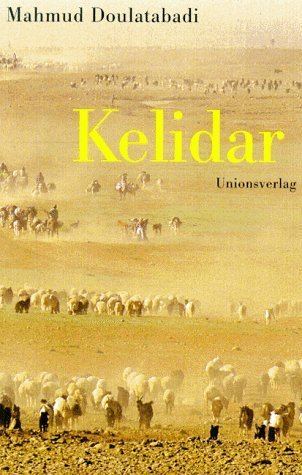Original title کلیدر Publication date 1984 Originally published 1984 Page count 2,836 ISBN 9783293201453 | Pages 2836 Genre Novel | |
 | ||
Novels The Blind Owl, The Unvanquished, Blood Promise, Windswept House: A Vatican N, Kiln People | ||
Kelidar (1977 to 1984) is Mahmoud Dowlatabadi's monumental novel, one of the most famous Persian novels. This novel is of nearly three thousand pages in five volumes consisting of ten books.
Contents
The author has used Folklore in writing Kelidar and he spent 15 years writing the novel. Kelidar has been translated into different languages.
Kelidar is the name of a mountain and a village in Khorasan where the events of the novel take place.
Plot
The story is about the life of a Kurdish family in Sabzevar, Khorasan faced with the hostility of neighboring villagers despite the similarity of their culture. It is set against the highly charged political climate in Iran after World War II, between 1946 and 1949.
Characters
"Illustrating the tragic fate of the Iranian peasantry and the nomadic tribes in a period of the power politics," and based on actual events, the novel follows the trials and tribulations of the Kalmiši family, and is peopled with an array of supporting characters.
Mārāl
Mārāl is a young Kurdish girl from the Kalmiši family.
Abdus
Mārāl's father
Delāvar
Mārāl's fiancé
Belqays
Mārāl’s paternal aunt, the matriarch of the family and the linking thread for the novel’s events and characters, and her husband, Kalmiši, have three sons and a daughter: Khan Moḥammad, Gol-Moḥammad, Beg Moḥammad, and Širu
Sattār
One of the supporters of Gol-Mohammad.
From the Reviews
"Kelidar is the longest Persian novel written to date, and surely one of the finest. The present translation is of parts I and 2 only, which are sufficiently self-contained to make for satisfying reading and which also give a good idea of what the whole is like. (...) Doulatabadi's style is that of a traditional Persian storyteller, in that he constructs his tale in a linear fashion, speaks through an omniscient narrator, and uses a balanced mixture of narrative and dialogue. (...) One wishes that readers of English could also experience the pleasures of this novel." - William L. Hanaway, World Literature Today
